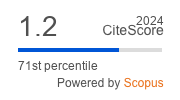The Semantic Space Structure of the Subject’s Сonception of His Own Mental Activity
Keywords:
reflexive activity, semantic space, categorical structure, method of semantic differential, metacognitive processes.Abstract
The article highlights the study of various forms of the subject`s reflexive activity. The offers a modified version of Semantic Differential, while determining the nature of the organization of the semantic space, which is an operational analog of the categorical structure of the subject`s consciousness of this content area. The level of the categorical structure’s difficulty is considered as an indicator of the subject`s ability to describe and evaluate his own forms of the internal activity, that are unfolding in the process of solving problems. The author identifies three levels of the reflexive activity: 1) cognitive level, where the subject uses only some reflexive acts; 2) metacognitive level, where the subject uses the planning, modeling, evaluation, monitoring and etc., aimed to the regulation of intellectual activity; 3) personal level, represented by a specially organized internal work of the subject. Through the use of the procedure of the special semantic differential, the author identified seven generalized features – factors that form the categorical structure of the subject: “active work over yourself’, “willingness to solve the problem”, “subject’s regulation of his own activity”, “monitoring his own work”, “order of the actions”, “active use of knowledge and experience”, “positive attitude to find a solution”. The presence of a well-developed system of the evaluations of this content area of subject`s consciousness indicates a high level of formation of the categorical structure, the functioning of which enables the subject to achieve efficiency in solving important tasks. Among them are timely identification of those aspects of the search decisions’ problems that lead to wrong actions, the formation of the ongoing monitoring of reflexive activity, the conduction of regular assessment of intermediate and final results by criteria efficiency, the correction of activity, the evaluation of the available resources and etc.
References
- Klymchuk, V. (2006). Faktornyi analiz: vykorystannia u psikholohichnykh
doslidzhenniakh [Factor analysis: use in psychological research]. Praktychna psikholohiya ta
sotsialna robota, 8, 43–48. - Petrenko, V. (1988). Psihosemantika Soznaniya [Psychosemantics of Consciousness].
Moscow: Moscow University. - Savchenko, O. (2012). Psikholohichnyi Analiz Sytuatsiyi [The Psychological Analysis of
the Situation]. Kherson: Vyshemyrskyi. - Subbotin, V. (2002). Otsenochnyie suzhdeniya. In: Kognitivnaya psihologiya, (рр. 315–
332). V. Druzhinin (ed.). Moscow: PER SE.







 Creative Commons «Attribution» 4.0
Creative Commons «Attribution» 4.0